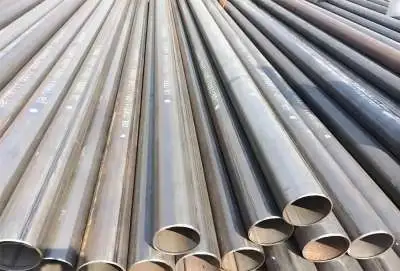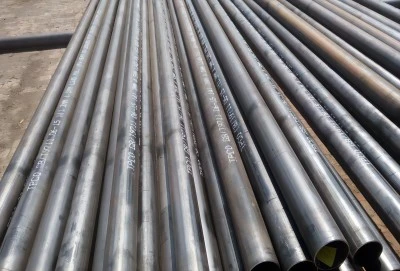High Frequency Welded (HFW) pipes have acquired huge prevalence in different enterprises because of their unrivaled quality and execution attributes. These pipes are produced utilizing a high level welding procedure that utilizes high-frequency electrical flow to join the edges of steel strips. This strategy offers a few benefits over customary pipe welding methods, making HFW pipes a favored decision for some applications. In this article, we will investigate the vital benefits of High Frequency Welded pipe and why they are turning out to be progressively significant in present day modern settings.
|
|
|
High Welding Speed:
One of the main benefits of High Frequency Welded pipe is the amazing welding speed accomplished during the assembling system. The HFW strategy uses high-frequency electrical flow, regularly in the scope of 100 to 500 kHz, which considers quick and concentrated warming of the steel edges. This limited warming empowers welding velocities of 150 to 200 meters each moment, which is significantly quicker than customary welding techniques.
Essentially increments creation proficiency, permitting producers to fulfill developing needs for steel pipes in different businesses. Clients will benefit from shorter lead times and lower generation costs as a result of this expanded proficiency. The steel is as it were subjected to tall temperatures for a brief sum of time amid the fast welding handle, which makes a difference protect the material's interesting properties and decreasing the chance of undesirable metallurgical changes.
The quick warming and cooling cycle progresses the improvement of a fine-grained microstructure in the weld locale, which overall shows preferable mechanical properties checked out over more sluggish welding strategies. HFW pipes are suitable for use in projects such as oil and gas, development, and water transportation because their fine-grained structure improves the pipe's overall strength and durability.
Small Heat-Affected Zone (HAZ):
Another crucial advantage of the products is the small heat-affected zone (HAZ) produced during the welding process. The HAZ is the area of base material adjacent to the weld that experiences changes in its microstructure and properties due to the heat of welding. In traditional welding methods, the HAZ can be relatively wide, potentially leading to areas of weakness or altered material properties in the finished pipe.
The HFW process, with its high welding speed and localized heating, results in a much narrower HAZ. This narrow HAZ is beneficial for several reasons. Firstly, it minimizes the extent of microstructural changes in the base material, helping to maintain the original properties of the steel throughout most of the pipe's cross-section. Secondly, the narrow HAZ is less prone to oxidation during the welding process, which can improve the overall corrosion resistance of the welded joint.
The combination of high welding speed and strong self-cooling effect in HFW pipes leads to welds with excellent structure and performance. The rapid cooling of the weld area promotes the formation of desirable microstructures, such as fine-grained ferrite-pearlite, which contribute to the weld's strength and toughness. This improved weld quality translates to enhanced overall pipe performance, particularly in applications where the pipe is subjected to high pressures, cyclic loading, or corrosive environments.
No Need for Pre-Weld Cleaning:
A significant operational advantage of the products is the reduced need for pre-weld cleaning. In conventional welding processes, thorough cleaning of the steel surface is often necessary to remove oxide films, dirt, and other contaminants that could interfere with weld quality. This cleaning step adds time and cost to the manufacturing process.
The HFW process, however, largely eliminates the need for pre-weld cleaning due to the unique properties of high-frequency current. The high voltage associated with the HF current can effectively conduct through the oxide film present on the steel surface. As the edges of the steel strip are brought together under pressure during welding, the high-frequency current helps to squeeze out any oxide films or surface contaminants.
This self-cleaning effect of the HFW process offers several benefits. It simplifies the manufacturing process by eliminating a time-consuming preparation step. It also contributes to improved weld quality by ensuring clean metal-to-metal contact at the weld interface, promoting strong metallurgical bonding. Additionally, the elimination of pre-weld cleaning reduces the use of cleaning chemicals and associated waste, making the HFW process more environmentally friendly.
Durable Welds:
The durability of welds is a critical factor in the performance and longevity of welded pipes, and this is an area where High Frequency Welded pipe excels. The HFW process creates welds that are known for their strength, durability, and ability to withstand significant strain without failure.
The high-frequency welding process results in a narrow, precisely controlled weld seam that, when properly executed, can be nearly indistinguishable from the base material in terms of strength and ductility. This seamless joint is capable of handling substantial mechanical stress and strain, making HFW pipes suitable for a wide range of demanding applications.
In applications such as liquid tanks and pressure vessels, the ability of HFW welds to maintain an airtight barrier is particularly valuable. The consistent, high-quality welds produced by the HFW process help ensure the integrity of the pipe or vessel, preventing leaks even under high pressure or cyclic loading conditions. This reliability is crucial in industries where pipe failure could lead to significant safety risks or environmental hazards.
Moreover, the durability of HFW welds contributes to the overall longevity of the pipe. This increased lifespan can lead to reduced maintenance costs and improved safety in critical applications such as oil and gas pipelines, where weld failures could have severe consequences.
High Frequency Welded Pipe Supplier:
As the advantages of High Frequency Welded pipe become increasingly recognized, many manufacturers are specializing in this technology. When selecting a supplier for HFW pipes, it's important to consider factors such as manufacturing capabilities, quality control processes, and adherence to relevant industry standards.
LONGMA GROUP's Standard Products: API 5L, ASTM A53, ASTM A500, ASTM A252, ASTM A795...If you are choosing your product manufacturers, welcome to contact us at info@longma-group.com.
In conclusion, High Frequency Welded pipes offer numerous advantages that make them an attractive choice for various industrial applications. Their high welding speed, small heat-affected zone, reduced need for pre-weld cleaning, and durable welds contribute to improved efficiency, quality, and performance. As industries continue to demand higher standards in pipe manufacturing, HFW pipes are well-positioned to meet these evolving needs.














